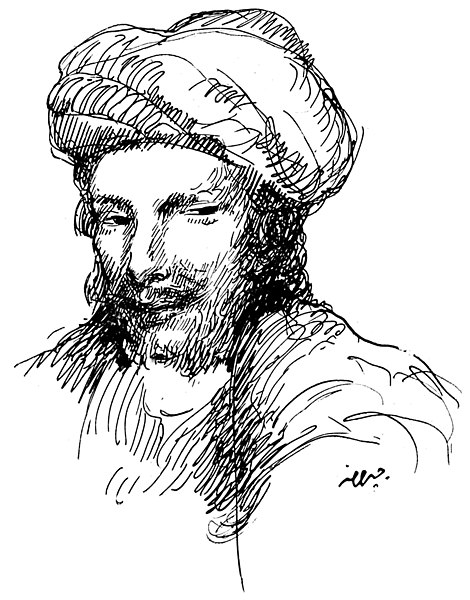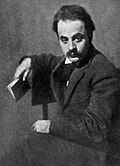
Vidi sliku u punoj veličini ((833 × 1.063 piksela, veličina datoteke: 323 KB, <a href="/wiki/MIME" title="MIME">MIME</a> tip: image/jpeg))
| Ova je datoteka sa stranica Zajedničkog poslužitelja Zaklade Wikimedije i smiju je rabiti drugi projekti. Opis s njezine stranice s opisom datoteke prikazan je ispod. |
Sažetak
| OpisAbu Nuwas.jpg |
Abu Nuwas, Drawing by Kahlil Gibran al-Funun 2, no. 1 (June 1916) Abu Nuwas was born in al-Ahwaz between 130 and 145 A.D. His father belonged to the army of Marwan II, the last Umayyad, while his mother was of Persian descent. His education as a youth took place in Basra and Kufa. He is said to have studied for a time among the Bedouins in order to improve his linguistic skill.1 The appearance of Abu Nuwas’ poetry in al-Funun was very appropriate in that he has been regarded by later day critics as the representative of a modern school of poets during his day. His remaining poetry, which contain many panegyrics to the Barmakids of Baghdad and al-Amin the son of Harun al-Rashid, imbued a freshness into the genre of classical Arabic poetry that made it appealing and alive; a fact which is still evident to this day. Though he composed many of his poems in the classical style, he was not limited to it. He injected into his poetry, which were often of very un-Islamic topics, such as wine and self-indulgence, a remarkable number of new terms, many of which were either Persian or vernacular expressions of the locale in which he resided. Abu Nuwas’ use of new words and vernacular expressions was very appealing to the literati gathering together through the auspices of al-Funun in New York City. He presented an example of an Arab poet who on the whole used language correctly though there may have been some errors grammatically in his poetry.2 The appearance of Abu Nuwas within al-Funun was in large part a legitimization, if one was truly needed, by those contributing to al-Funun for their right to experiment with the Arabic language. He represented one of the great poets from the golden age of Arabic literature who wrote creative and appealing poetry, but who did it in a fresh, appealing manner and in his own way. |
|||||||||||||||||||||||
| Datum | ||||||||||||||||||||||||
| Izvor | https://www.kahlilgibran.com/digital-archive.html?category[0]=1&category_children=1&own=0&tag[0]=abi-nawas | |||||||||||||||||||||||
| Autor |
creator QS:P170,Q47737 |
|||||||||||||||||||||||
Licencija
| Public domainPublic domainfalsefalse |
|
Ovo je djelo u javnom vlasništvu u zemlji podrijetla i u drugim zemljama s rokom trajanja autorskih prava za života autora plus 70 godina ili manje. Note that a few countries have copyright terms longer than 70 years: Mexico has 100 years, Jamaica has 95 years, Colombia has 80 years, and Guatemala and Samoa have 75 years. This image may not be in the public domain in these countries, which moreover do not implement the rule of the shorter term. Honduras has a general copyright term of 75 years, but it does implement the rule of the shorter term. Copyright may extend on works created by French who died for France in World War II (more information), Russians who served in the Eastern Front of World War II (known as the Great Patriotic War in Russia) and posthumously rehabilitated victims of Soviet repressions (more information).
| |
| Ova datoteka je identificirana kao slobodna od poznatih ograničenja po zakonu o autorskim pravima, uključujući sva povezana i srodna prava. | |
https://creativecommons.org/publicdomain/mark/1.0/PDMCreative Commons Public Domain Mark 1.0falsefalse
Opisi
lipanj 1916Gregorijanski
image/jpeg
checksum engleski
638f29bfcf4d7514760056463d42d63746b1c055
data size engleski
330.626 Bajt
1.063 točka
833 točka
Povijest datoteke
Kliknite na datum/vrijeme kako biste vidjeli datoteku kakva je tada bila.
| Datum/Vrijeme | Minijatura | Dimenzije | Suradnik | Komentar | |
|---|---|---|---|---|---|
| sadašnja | 20:17, 7. kolovoza 2019. |  | 833 × 1.063 (323 KB) | FunkMonk | Bigger. |
Poveznice
Na ovu sliku vode poveznice sa sljedećih stranica:
Metapodatci
Ova datoteka sadržava dodatne podatke koje je vjerojatno dodala digitalna kamera ili skener u procesu snimanja odnosno digitalizacije. Ako je datoteka mijenjana, podatci možda nisu u skladu sa stvarnim stanjem.
| Orijentacija kadra | Normalno |
|---|---|
| Vodoravna razlučivost | 72 dpi |
| Okomita razlučivost | 72 dpi |
| Korišteni softver | Adobe Photoshop CS3 Windows |
| Datum posljednje promjene datoteke | 22:17, 7. kolovoza 2019. |
| Kolor prostor | Nekalibrirano |
| Važeća širina slike | 833 px |
| Važeća visina slike | 1.063 px |
| Datum i vrijeme digitalizacije | 00:17, 8. kolovoza 2019. |
| Datum posljednje promjene metapodataka | 00:17, 8. kolovoza 2019. |
